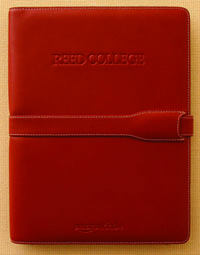The term augmented reality, which I guess as owner of this blog I should define for my audience, is a term for a live direct or indirect view of a physical real-world environment whose elements are augmented by virtual computer-generated sensory input such as sound or graphics (possibly in the future smell and touch). Looking at the definition AR devices could be extremely varied.
Being so varied I would like to include slate computers and e-books, which in some ways try to mirror books, which exist in the real world (for now). I was exploring twitter links and retweets and found mention of a report done on the much touted study by Amazon of the Kindle DX in college environments. This study at Reed College was undertaken as a product evaluation for Amazon, but was also grown by the evaluators as an opportunity to identify the impacts that Kindle/ebooks might have on teaching and learning activities.
The courses chosen were text heavy and tech light courses. The faculty chosen was fairly technically astute. 46 Students were registered for the classes and nearly all the students participated (43 students participated). To garner feedback web surveys were used pre and post assessment, along with e-mails.
Positive finding of the Amazon Kindle were they were much easier to read than on laptops, the form factor (able to sit and lay), battery life was outstanding, proved very durable, very little extra paper had to be used, wireless and cellular distribution and the single function benefit.
Some of the negative findings were materials availability, PDF formatting, PDF distribution (10 cents), lack of color & images, refresh rate lagged behind LCD screens (problem with skimming), pagination (not able to be used as reference), multiple texts, with the real pain being in highlighting and adaptation. Of particular note is the comparison video of working with the iphone vs. kindle.
Content comprehension was the big looser in the Kindle study and implementation. It seems that the students were not able to interact with the media as efficiently as was done on paper. They were only able to read linearly and not able to highlighting and annotating. The students no longer interacted with the text, merely passively reading the text.
I think the students should have been given the option of getting the text as well. Through formative assessments throughout the study adjustments could have been made as well. With these adjustments being made within the study better information could have been garnered on using ebooks as a compliment to current materials. I noticed that it was mentioned about the apprehension of students wanting to layout additional money for an additional device beyond the books and laptops was still in questions. Speaking as a student, I couldn’t wait until the ipad was available and the only reason I didn’t get a Kindle immediately was because of its size. The product I was actually blown away by initially was that of the Plastic Logic team (yet to come out as promised). My “first kiss” product was the Sony E-book Reader, which made me fall in love with the whole bunch of them.
The future of ebook readers has definitely arrived since last fall when this study was done. I can’t wait to see how the academy welcomes the readers with its new drop in price point and widening availability and growing prices of texts.
References
Dr. Martin Ringle, D. T. M. (Producer). (2009, November 10, 2010) Amazon Kindle DX Pilot Project Overview. Video retrieved from http://bcis.pacificu.edu/roundtables/Presentations/2010/index.php


No comments:
Post a Comment